Services on Demand
Journal
Article
Indicators
-
 Cited by SciELO
Cited by SciELO -
 Access statistics
Access statistics
Related links
-
 Cited by Google
Cited by Google -
 Similars in
SciELO
Similars in
SciELO -
 Similars in Google
Similars in Google
Share
Ingeniería y Universidad
Print version ISSN 0123-2126
Ing. Univ. vol.16 no.2 Bogotá July/Dec. 2012
Evaluation of Microalgal Mortality in a Centrifugal Pump of a Tubular Photobioreactor1
Evaluación de la mortalidad microalgal en una bomba centrífuga de un fotobiorreactor tubular2
Avaliações de mortalidade de microalgas em uma bomba centrífuga de um fotobiorreator tubular3
José Luis Ramírez-Duque4
David Alberto Marín-Quintero5
Cristian Hernán García-Pulido6
1This article is derived from the research project Design of a Photobioreactor for Biomass Production from Algae as a Cleaner Energy Source in the Department of Valle del Cauca, developed by the research group GRUBIOC of Universidad Autónoma de Occidente, Cali, Colombia.
2Fecha de recepción: 27 de octubre de 2011. Fecha de aceptación: 28 de abril de 2012. Este artículo se deriva del proyecto de investigación Diseño de un prototipo de fotobiorreactor para la producción de biomasa a partir de algas como fuente de energía más limpia, en el departamento del Valle del Cauca, desarrollado por el grupo de investigación GRUBIOC, de la Universidad Autónoma de Occidente. Cali, Colombia.
3Data de recebimento: 27 de outubro de 2012. Data de aceite: 28 de abril de 2012. Este artigo derivou-se do projeto de pesquisa Desenho de prototipo de fotobiorreator para a produ¡do de biomassa a partir de algas como fonte de energia mais limpa,no departamento do Valle del Cauca, desenvolvido pelo grupo de pesquisa GRUBIOC, da Universidade Autónoma de Ocidente. Cali, Colombia.
4Ingeniero mecánico, Universidad Tecnológica de Pereira, Pereira, Colombia. Magíster en Ingeniería Mecánica, Universidad del Valle, Cali, Colombia. Estudiante del Doctorado en Ingeniería Mecánica, Universidad de São Paulo, São Paulo, Brasil. Profesor de tiempo completo, Universidad Autónoma de Occidente. Cali, Colombia. Correo electrónico: ioslurad@hotmail.com.
5Ingeniero mecánico, Universidad Autónoma de Occidente. Cali, Colombia. Independiente., Universidad Autónoma de Occidente. Cali, Colombia. Correo electrónico: david_alberto.marin@uao.edu.co.
6Ingeniero mecánico, Universidad Autónoma de Occidente. Independiente. Universidad Autónoma de Occidente. Cali, Colombia. Correo electrónico: cristian_her.garcia@uao.edu.co.
Submitted on: October 27,2011. Accepted on: April 28,2012.
Resumen
Las bombas centrífugas son de gran utilidad industrial y dentro de sus aplicaciones se puede encontrar el bombeo de fluidos que contienen microorganismos vivos en suspensión. Sin embargo, este tipo de bombeo puede afectar el desarrollo de los microorganismos, ya que genera altos esfuerzos cortantes, que no son soportables por sus paredes celulares, lo cual se traduce en una elevada mortalidad celular. En este artículo se analizó computacionalmente una bomba centrífuga utilizada para el bombeo de cultivos microalgales en fotobiorreactores tubulares. Para ello, se modeló la geometría tanto de la voluta como del impeler en CAD, para posteriormente efectuar una simulación en CFX según las condiciones de operación de un fotobiorreactor. La evaluación de la distribución de velocidad y de los esfuerzos cortantes dentro de la bomba llevó a concluir que es inviable la utilización de estos mecanismos de bombeo, dada la alta mortalidad que se puede presentar para ciertas especies microalgales, como es el caso de la Chaetoceros muel-leri, en la cual su viabilidad se puede reducir hasta niveles del 52%.
Palabras clave: Esfuerzo cortante, fotobiorreactor, bio-masa microalgal, dinámica de fluidos computacional.
Abstract
Industrially, the centrifugal pumps are very useful and within their applications, it can be found pumping fluids containing living microorganisms in suspension. However, this type of pumping can affect the growth of microorganisms because it generates high shear stresses, which are not supported by their cell walls, resulting in high cell mortality. In this article, we analyzed computationally a centrifugal pump used for pumping microalgal cultures in tubular photo-bioreactors. To do this, we modeled in CAD both the impeller and the volute; and then we conducted a simulation in CFX under the operation conditions of a photobioreactor. The evaluation of the velocity distribution and shear stresses inside the pump, led to conclude that it is impractical to use these pumping mechanisms, due to the high mortality rate that is expected for some microalgae species, such as the Chaetoceros muelleri; for which its viability can be reduced to levels of 52%".
Key words: Shear stress, Photobioreactor, Microalgae biomass, Computational fluid dynamics (CFD).
Resumo
As bombas centrífugas são de grande utilidade industrial e nas suas aplicações pode se encontrar o bombeamento de fluidos que contem micro-organismos vivos em suspensão. Contudo, este tipo de bombeio pode afetar o desenvolvimento de microrganismos, pois gera fortes cisalhamentos, nem sempre suportados pelas paredes celulares, o que resulta em uma elevada mortalidade das células. Este artigo analisou computacionalmente uma bomba centrífuga usada para bombeamento de cultivos de microalgas em fotobiorreatores tubulares. Para isso, modelou a geometria tanto da voluta quanto do impulsor em CAD, para posteriormente proceder a uma simulação em CFX, em acordo com as condições de funcionamento de um foto-biorreator. A avaliação da distribuição da velocidade e dos cisalhamentos no interior da bomba levou a concluir que a utilização de tais mecanismos de bombeamento é inviável, dada a elevada taxa de mortalidade que pode estar ocorrendo a certas espécies de microalgas, como o caso da Chaetoceros muelleri, na que a viabilidade pode se reduzir até níveis de 52%.
Palavras-chave: Cisalhamento, fotobiorreator, biomassa de microalgas, dinâmica de fluidos computacional.
Introduction
Because of the high cost of the fossil fuels and the increasing concerns about their negative environmental impact, especially due to their influence on the climatic change; there is an increased interest in the use of designated biofuels, such as biodiesel and bioethanol (Rosello et al., 2007). The biodiesel is a fuel that can be obtained from organic, vegetable or animal oils through a process designated transesterfication (Demirbas, 2007). To obtain vegetable oils we can find the green plants and the seaweeds cultivated in open or closed systems (pho-tobioreactors). To develop of sustainable way the crop and massive production of microalgae, it is essential to know and define some appearances such as the type of microorganisms that are going to be used, their conditions and requirements for an optimum growth, and the resistance to different environmental variables. The closed reactors or photobioreactors are the systems that provide the highest guarantees for the process because of the ease of control of these variables, which help achieving the best conditions for the correct growth and reproduction of microalgae.
The development of the technology to produce biofuel by microalgae cultures is important in Colombia because it can lead to the substitution of petroleum fuels and their derivatives, which are becoming scarcer. In addition, the process to obtain biodiesel through seaweed cultivation favores the decrease of global warming; through the sequestration of carbon dioxide (CO2) and release of oxygen (O2).
The first signs of algal cultures dates back to the time of the Second World War. Germans grew algae in open ponds mainly as food supplements. From the decade of the fifties, scientific studies were conducted with the purpose of obtaining, from microalgae, a new source of energy capable of replacing the use of oil and fossil hydrocarbons, which in turn could protect the environment (Ramirez and Ramos, 2011). In the late 1970's, the production of algae began in Eastern Europe, Israel and Japan; algae were grown in open tanks as healthy food. It is a fact that the purpose of algal growth depends on the specific needs of a population. U.S. microalgae pond systems were developed for the treatment of water; the biomass collected was used as an energy source (Burlew, JS, 1953). Over time, biomass, besides being used for bioenergetic purposes, has been used in pharmaceuticals, nutraceuticals, agrochemicals, food, etc. (Camacho et al., 1999).
Due to the fact that the closed systems surpass the open systems, the design of the photobioreactors is the point of focus as it is the main point of control of the culture conditions in closed systems. The most effective systems use solar energy for photosynthesis necessary for mass production of microalgae. Among the most used photobioreactors are the tubular, columns of bubbles, and the signpost or plate.
The tubular photobioreactors are closed systems developed for the production of microalgae that prevent external contaminants from accessing the culture, since it remains isolated and prevents their contact with the outside air. There are several methods used to achieve the movement and circulation of the culture through it, including mechanical agitator and air injectors. (Camacho et al., 1999). Commonly, these photobioreactors have a unit called airlift that, by air injection, generates the movement while performing the degasification in the collector, removing dissolved oxygen that results from the photosynthesis of the algae (Pruvost, Cornet, and Legrand, 2008). The airlift control also determines the magnitude of shear stress, which is one of the most important parameters in microalgae biomass production. With the airlift system, high magnitudes of shear stress can be prevented, which allows the protection of the cells of the algae. (Michels et al., 2010).
In this study a centrifugal pump was designed and simulated through CAD and CAE packages. The clime conditions of Valle del Cauca (Colombia) were considered in the definition of initial parameters in the design of a pumping systems for a photobioreactor with a capacity of 250L.
1. Circulation of the culture medium and shear stress
The method for circulating the liquid through the photobioreactor is an important consideration in the design of these systems (Ramirez and Ramos, 2011), the rotary pallets in the open reactors, the positive displacement pumps, rotary or of screw and in general any method has a big disadvantage and that is the one to produce large shear stresses to cells, damaging them.
The hydrodynamic forces generated by these systems could cause shear stresses affecting algae (Mazzuca et al., 2006; Sánchez et al., 2000), reducing its rate of growth or causing cell death. This shear stress is directly related to the viscosity of the culture medium and the rate of deformation (Mott, 2005).
The tolerance of these microorganisms to shear stresses depends specifically on the microalgae-like species. In particular, the species Chaetoceros muelleri can tolerate stresses of 1.8Pa with no modification in their growth process (Michels et al., 2010). The growth of the microalgae Spirulina platensis is affected when the microalgae is subjected to shear stresses over 0.3Pa (Mitsuhashi et al., 1995) although there is no significant cell damage. While for the highly sensitive microalgae-like species Protoceratium reticulatum, there was a threshold of damage to an average shear stress of about 0.16 MPa (Garcia et al., 2007); for the species Phaedactylum tricornutum, a value of shear stresses of 7Pa led it to the highest growth rate caused by a balance between the mass transfer limitations and shear damage (Contreras et al., 1998).
In horizontally arranged tubular photobioreactors is common to use the hydro-pneumatic method based on the airlift principle (Richmond et al., 1993; Sánchez et al., 2000). The speed of culture medium in the tubes must be sufficient to ensure a turbulent flow that prevents growth in the tube wall or sedimentation of the cells; and to allow a favorable lighting regime system to establish an intense photosynthesis (Gudin and Chaumont, 1991; Camacho et al., 1999; Molina et al., 1999). A low flow of fluid (< 15cm/s) almost always produces growth in the wall and a possible growth inhibition by high concentrations of dissolved O2. A liquid velocity in pipes of 30-50 cm/s is appropriate in most cases.
2. Methodology
2.1 Modeling of Parts
In order to explore the operation of the centrifugal pump it was necessary to model it using a CAD system; for this project it was used Solid Edge V20 where 3 basic parts were made: the volute, the impeller and a cylindrical region corresponding to the input of the working fluid (water) (Figure 1).
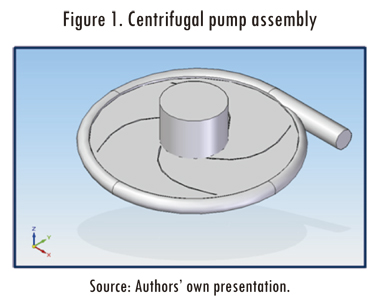
For the modeling of parts, the size and actual operating conditions of the centrifugal pump were taken into account to be tested.
It was important to take into account dimensions like the entrance and exit diametersof the impeller, the impeller thickness and the thickness of the blade, the form of the volute and the outlet diameter of it. Likewise some characteristics were retained like the number of blades and their measures. Table 1 indicates the operating characteristics of the pump.
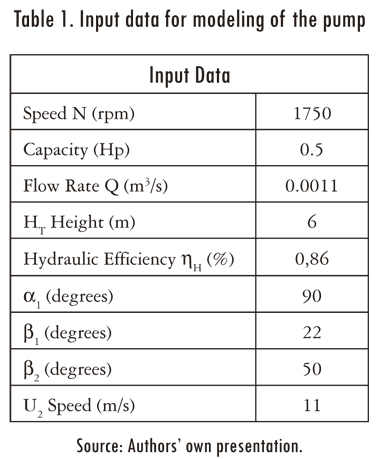
Where:
- β1 and α1correspond to angles of the triangle of input speeds and provide information on the tilt angle of the blade (Mataix, 1986).
- U2 speed corresponds to the absolute velocity of the vane at the inlet and the angle β2 is the output blade angle (Mataix, 1986).
2.2 Meshed and Boundary Conditions
In order to simulate and analyze this pump, it was applied a meshing to the final assembly of the pump; for this, the Mesh application of CFD in Ansys was used. The mesh type selected for this application was an independent tetrahedral due to the snail shape and the impeller blades. The mesh was made with a size of element of 1E-3 m. The result of the meshing can be seen in Figure 2.
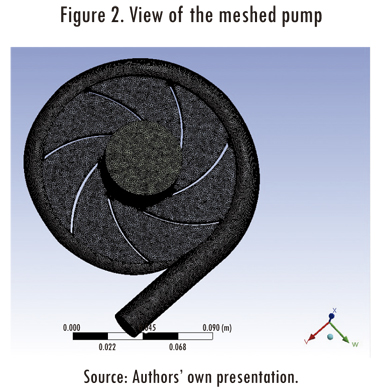
To apply the boundary conditions in the simulation program, three fluid domains were created.
The impeller which formed the rotary fluid domain with an angular speed of 1750 RPM, had the wall boundary conditions for the blades and the upper and lower sides of it.
The snail or volute that formed the static fluid domain; in this domain was the wall condition to the outer edges of the snail, and the outlet exit condition with a normal speed of 0.48 ms/1.
The inlet region which conformed a fluid domain; in this domain was the wall condition at the bottom of this region and the inlet condition that is responsible of recognizing a mass flow of 1.1 kg/s-1.
Apart from the process described previously, some conditions of interface were applied in areas with which fluids interact. These interfaces were applied where the domains of the impeller and the inlet region are connected, as well as where the volute and the impeller are connected.
Figure 3 shows the pump with the boundary conditions of inlet and outlet in the inlet and outlet regions of the volute respectively.
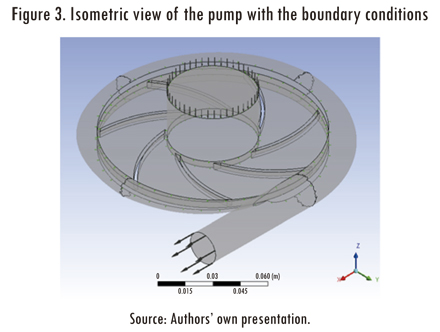
3. Results and computational analysis
Once the boundary conditions were implemente, we proceeded to perform the simulation using the SST model (shear stress transport). Subsequently, the analysis of the simulation results were conducted.
In Figure 4 we can see the results of the speed values in the volute wall. It can be concluded that it achieves a maximum value of 12 m/s-1 through the entire path except in the exit where the magnitude decreases due to border conditions where the speed value was 0.48 m/s-1. The tool used to determine the value of the velocity within the volute is Streamlines, which give us an idea of the water path into the shell.
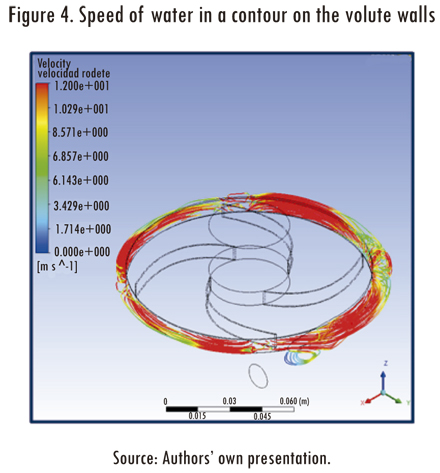
Figure 5 shows the velocity of the fluid within the impeller; this domain corresponds to the rotary fluid. This figure was obtained using velocity values corresponding to a plane passing through the middle of the impeller; one can see the maximum speed value of 8 m/s-1, that are located in bordering areas with the interface. Between the blades one can see speeds of order 3.4 m/s-1; it is also noticeable how the fluid that is close to the front face of the blades has minimum speeds, while the fluid in the rear face reaches higher speeds. In this figure it is possible to determine why in this type of pump are such high shear stresses, as there are high variations in the fluid velocity, which is directly related to the velocity gradients occurring in the pump.
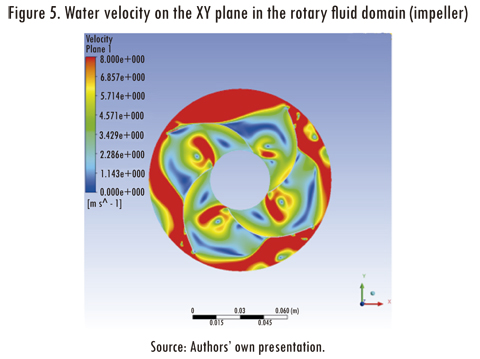
The Streamlines tool was used to determine the velocity in the static fluid domain immersed in the shell. Starting at the interface with the impeller, we observed a variation of speed of 13 m/s-1 to 2 m/s-1 (Figure 6). In the final section of the volute there were very few Streamlines due to the outlet condition of flow in the volute.
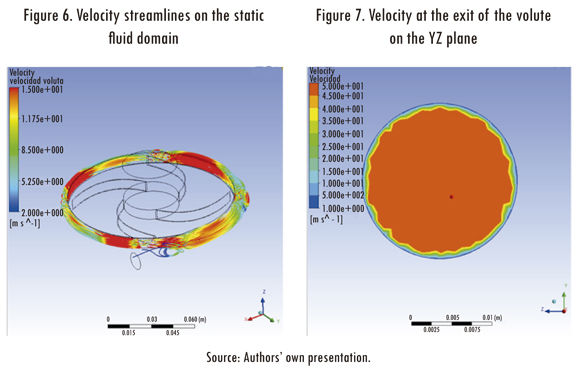
Figure 7 shows the behavior of the velocity at the outlet of the volute with a view of the YZ plane, which shows how the fluid velocity on the walls takes a value of 0 m/s-1 while in the middle of the duct, it takes the value assigned to the outlet condition.
In order to find the shear stress between the fluids it was applied the Eq. 1 for Newtonian fluids. According to this equation knowing the kinematic viscosity of water and the velocity gradient in the Y axis (Z was the coordinates axis of our design) it is possible to find the shear stress presented. To find it, a line was inserted in a section of the volute in order to determine the value of the velocity gradient in this specific line (Figure 8). It can be seen that this line is located to the sides of the volute walls in order to analyze a point where the shear stress is high.
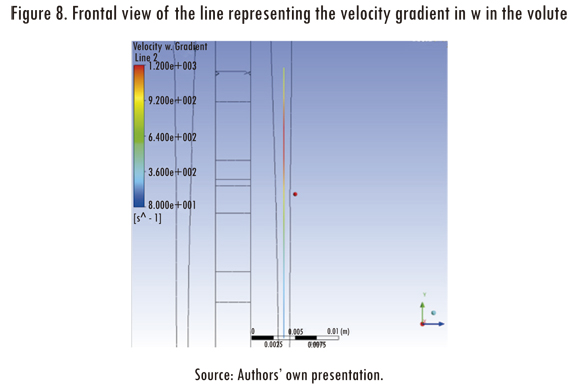

Where:
τ, shear stress.
μ, dynamic viscosity of water.
δu/δy, velocity gradient in Y direction.
Data values of the velocity gradient were exported and once this step was done they were tabulated for the shear stress graph, which is presented in Figure 9. The greater observed stress was 0.4 Pa.
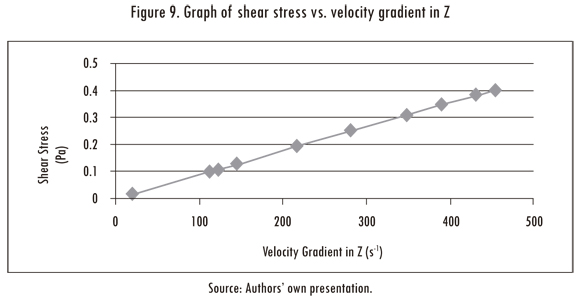
This chart was made taking into account the values of the volute. In Figure 10 one can see this line but in the rotary fluid domain (i.e., the impeller), which in this case reached values of 1200 s-1. These values are greater than the values found in the volute as this domain is exposed to the blades movement.
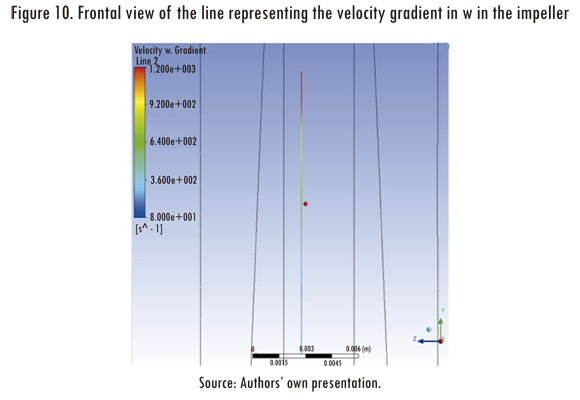
In Figure 11 it is shown the graph of shear stress vs. shear rate in the rotating fluid domain, which gives a value of maximum stress of 1.2 Pa.
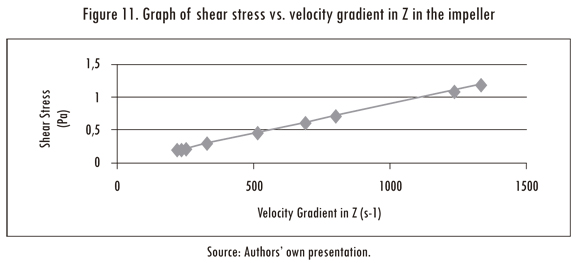
This value of shear stress supposes a potential risk for the microalgae culture, because as mentioned before, diverse microalgal species, such as the Spirulina platensis, reduce their growth rate at magnitudes above 0.3 Pa. This is concerning if it is considered that there are many other species of greatest sensitivity.
In the study developed by Michels et al., (2010), the answer of the species Chaetoceros muelleri is analyzed as the shear stress is increased. The authors found that values of the shear stress up to 1 Pa, had no effect on the feasibility of the culture. But shear stress levels above 1.3 - 1.8 Pa produce a strong fall of the culture feasibility, which can reach feasibility values between 52 and 66% (Figure 12).
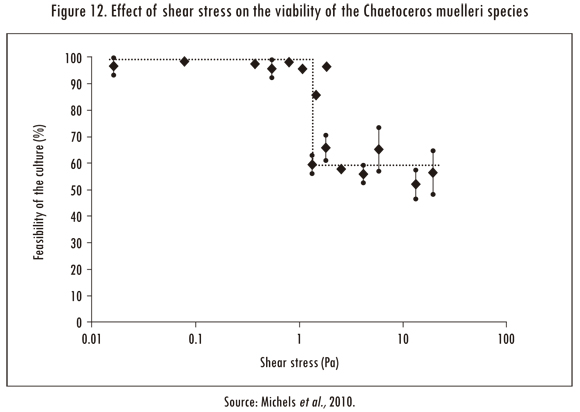
It is evident, therefore, that these values of shear stress to which microalgae are subjected in a pumping system as the analyzed in this paper, are in the stress limits at which microalgae life begins to be negatively affected.
4. Conclusions
Using pumping mechanisms for microalgal culture such as those described in this article are not recommended due to the high cell mortality that is produced. The computational analysis indicate that the shear stresses that are formed inside the centrifugal pump reach values ranging from 0.4 Pa in the volute of the pump to 1.2 Pa in the impeller. This large shear stress in the last section of the pump are due to the movement of the blades. According to previous studies, at the this values, the feasibility of algae cultures could be reduced to 52% (Michels et al., 2010). However, there are more critical areas within the pump, such as the walls of the impeller and the volute, where shear stresses reached up to 250 Pa, which make these pumping mechanisms too threatening for these microorganisms.
The computational analysis resulted in values values of efforts that are not permissible for the microalgae, causing the culture to be affected and therefore the production may be lost.
It is recommended to consider systems for circulation and mixing of micro-algae through a photobioreactor that result in conditions that are less critical to microalgae.
References
BURLEW J. S. Algal culture from laboratory topilotplant. Washington: Carnegie Institution, 1953. [ Links ]
CAMACHO, F.; ACIÉN, F. G.; SÁNCHEZ, J. A. et al. Prediction of dissolved oxygen and carbon dioxide concentration profiles in tubular photobioreactors for microalgal culture. Biotechnology and Bioengineering. 1999, vol. 62, no. 1, pp. 71-86. [ Links ]
CONTRERAS, A.; GARCÍA, F.; MOLINA, E. et al. Interaction between CO -mass transfer, 2 light availability, and hydrodynamic stress in the growth of Phaeodactylum tricornutum in a concentric tube airlift photobioreactor. Biotechnology and Bioengineering. 1998, vol. 60, no. 3, pp. 317-325. [ Links ]
DEMIRBAS, A. Importance of biodiesel as transportation fuel. Energy Policy. 2007, vol. 35, no. 9, pp. 4661- 4670. [ Links ]
GARCÍA, F.; GALLARDO, J. J.; SÁNCHEZ, A. et al. Determination of shear stress thresholds in toxic dinoflagellates cultured in shaken flasks Implications in bioprocess engineering. Process Biochemistry. 2007, vol. 42, pp. 1506-1515. [ Links ]
GUDIN, C. and CHAUMONT, D. Cell fragility - the key problem of microalgae mass production in closed photobioreactors. Bioresource Technology. 1991, vol. 38, no. 7-8, pp. 145-151. [ Links ]
MATAIX, C. Mecánica de fluidos y máquinas hidráulicas. México: Alfaomega-Oxford, 2005. [ Links ]
MAZZUCA, T.; GARCÍA, F.; MOLINA, E. et al. Effects of agitation on the microalgae Phaeodactylum tricornutum and Porphyridium cruentum. Bioprocess and Biosystems Engineering. 2006, vol. 28, no. 4, pp. 243-250. [ Links ]
MICHELS, M.; VAN DER GOOT, A.; NORSKER, N. H. et al. Effects of shear stress on the microalgae Chaetoceros muelleri. Bioprocess and Biosystems Engineering. 2010, vol. 33, no. 8, pp. 921-927. [ Links ]
MITSUHASHI, S.; HOSAKA, K.; TOMONAGA, E. et al. Effects of shear flow on photosynthesis in a dilute suspension of microalgae. Applied Microbiology and Biotechnology. 1995, vol. 42, no. 5, pp. 744-749. [ Links ]
MOLINA, E.; ACIÉN, F. G., GARCÍA, F. et al, Y Photobioreactors: Light regime, mass transfer, and scale up. Journal of Biotechnology. 1999, vol. 70, no. 1-3, pp. 231-247. [ Links ]
MOTT, R. L. Applied fluid mechanics. 6th Edition. USA: Prentice Hall, 2005, pp. 597. [ Links ]
PRUVOST, J.; CORNET, J. F. and LEGRAND, J. Hydrodynamics influence on light conversion in photobioreactors: An energetically consistent analysis. Chemical Engineering Science. 2008, vol. 63, no. 14, 3679-3694. [ Links ]
RAMÍREZ-DUQUE, J. L. and RAMOS, M. A. Hydrodynamic computational evaluation in solar tubular photobioreactors bends with different cross sections. CtandF - Ciencia, Tecnología y Futuro. 2011, vol. 4, no. 4, pp. 59-72. [ Links ]
RICHMOND, A.; BOUSSIBA, S.; VONSHAK, A. et al. A new tubular reactor for mass production of microalgae outdoors. Journal of Applied Phycology. 1993, vol. 5, no. 3, pp. 327-332. [ Links ]
ROSELLO, R.; CSÖGÖR, Z.; PERNER-NOCHTA, I. et al. Scale-down of microalgae cultivations in tubular photo-bioreactors-A conceptual approach. Journal of Biotechnology. 2007, vol. 132, no. 2, pp. 127-133. [ Links ]
SÁNCHEZ, A.; GARCÍA, F.; CONTRERAS, A. et al. Bubble column and airlift photobioreac-tors for algal culture. Aiche Journal. 2000, vol. 46, no. 9, pp. 1872-1877. [ Links ]
Vaxa Software. Viscosidad dinámica del agua líquida a varias temperaturas [web en línea] <http://www.vaxasoftware.com/doc_edu/qui/viscoh2o.pdf> [consulta: 15-2-2011] [ Links ].













